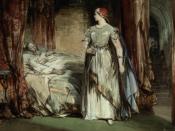Though this be madness, yet there is method in't.
An essay on Shakespeare's use of madness
The Tragedies Of Shakespeare
20 December, 1996
Page 1
'Your noble son is mad --
'Mad' call I it, for to define true madness,
What is't but to be nothing else but mad?'
(Wells and Taylor, 665)
In Act two, scene two of William Shakespeare's play Hamlet, Polonius uses these words to inform Hamlet's parents of their son's insanity. He then continues on, telling Gertrude and Claudius that the cause of this madness is lovesickness over his own daughter Ophelia (665). From the privileged perspective of the audience, we know that Polonius is mistaken and that Hamlet is far from insane, but rather, 'playing mad' for a purpose of his own. Madness in Shakespearean plays, and in tragedies in particular, is rarely what it seems on the surface. Instead, both madness and the characters experiencing it are layered with meaning; like an onion, layer after layer can be peeled off, eventually allowing a glimpse at the core concealed within.
Shakespeare's treatment of the character Hamlet is typically multi-faceted and complex--Hamlet appears insane, ostensibly over
Page 2
Ophelia, however, his madness is feigned--a cover for internal conflicts, rooted not in thwarted affection, but rather in desire to avenge his father's murder. Hamlet even goes so far as to say his apparent madness is an act when he says 'I am but mad north-north-west; when the wind is southerly, I know a hawk from a handsaw'(667).
Shakespeare often used madness, either feigned or actual, as a teaching tool or vehicle to advance his plot. Sometimes this madness was feigned, as evidenced by Hamlet and Edgar (the legitimate son of Gloucester in The Tragedy of King Lear), but other times it was genuine insanity. Ophelia and...


